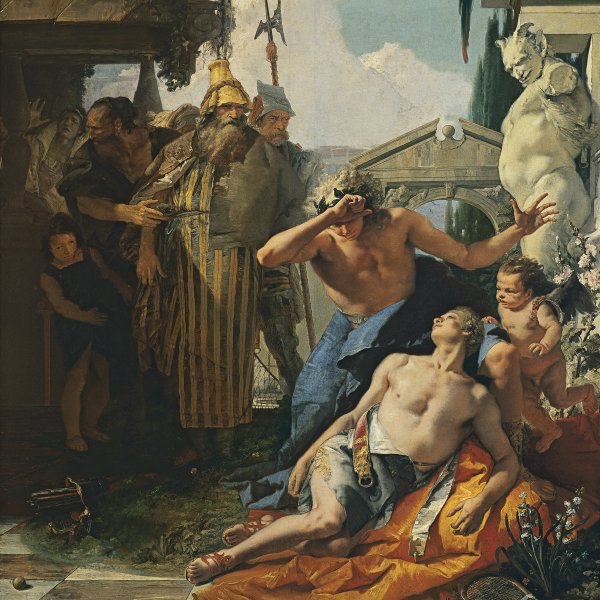The Expulsion of the Money-changers from the Temple
ca. 1750 - 1753
Oil on canvas.
104 x 195 cm
Colección Thyssen-Bornemisza, on deposit at the Museu Nacional d'Art de Catalunya (MNAC)
Inv. no.
398
(1955.3
)
Not on display
Level 2
Permanent Collection
Level 1
Permanent Collection
Level 0
Carmen Thyssen Collection and Temporary exhibition rooms
Level -1
Temporary exhibition rooms, Conference room and EducaThyssen workshop
Giandomenico Tiepolo, eldest son of Giambattista, trained in the family circle and was his father’s most active assistant. He learned his profession by drawing copies of his father’s compositions. Giandomenico took part in the major decorative projects commissioned from Giambattista, such as the residence of the
Prince-Bishop in Würzburg of 1750 to 1755, as well as those in Valmarana in 1757 and the Royal Palace in Madrid between 1762 and 1770. Aside from these family projects, Giandomenico worked independently as we know from the fourteen canvases of the “Via Crucis” that he painted for the Venetian church of San Polo between 1747 and 1749, begun when he was only twenty. This series has been seen to deploy a realism in the treatment of figures and compositions that constitutes an innovation in the family output.
The episode of the Expulsion of the Money-changers from the Temple is recounted in the Gospels. According to the account in Saint John, Christ made a whip or scourge of small cords, entered the temple and expelled all those who were buying and selling, overturning the tables of the money-changers and the seats of the dove sellers and scattering all the money. Giandomenico closely follows the New Testament account in his canvas. Thus we see Christ on the left holding the whip while the traders have fallen to the ground though the force of his advancing presence. The traders in the background are seen running away in different poses, a woman on the left holding a lamb and one on the right leading an ox. The animals, which were temple offerings, were carefully selected to suit all pockets with the doves being the cheapest and the sheep and oxen for richer worshippers. The horizontal setting with its low viewpoint depicts the Temple in Jerusalem, here imagined by the artist has having monumental, classical walls with semi-circular arched openings.
In order to establish its date the painting has been compared to three other oils by Giandomenico: The Last Supper (Würzburg, Würzburg Staatsgalerie), The Supper in the House of the Pharisee (Munich, Alte Pinakothek), and The Institution of the Eucharist (Copenhagen, Statens Museum for Kunst). The first two were part of a series painted for the palace at Veitshöchheim and all three can be dated to Giandomenico’s time in Würzburg. The influence of his father Giambattista has also been detected in the present canvas, and it has been compared to Esther and Ahasuerus in the Bührle collection in Zurich, a work that Giandomenico would very probably have known. Giambattista’s influence has also been detected in specific figures such as the woman holding up the bag of money and the one seated beside the cage of birds whose closest precedent is to be found in the Barbaro cycle, executed just before the trip to Würzburg.
Aside from these borrowings, the canvas is characteristic of Giandomenico in its distinctive colour range and in the unusual and comic figure of the trader in the foreground who has fallen on his face onto the ground.
Mar Borobia
The episode of the Expulsion of the Money-changers from the Temple is recounted in the Gospels. According to the account in Saint John, Christ made a whip or scourge of small cords, entered the temple and expelled all those who were buying and selling, overturning the tables of the money-changers and the seats of the dove sellers and scattering all the money. Giandomenico closely follows the New Testament account in his canvas. Thus we see Christ on the left holding the whip while the traders have fallen to the ground though the force of his advancing presence. The traders in the background are seen running away in different poses, a woman on the left holding a lamb and one on the right leading an ox. The animals, which were temple offerings, were carefully selected to suit all pockets with the doves being the cheapest and the sheep and oxen for richer worshippers. The horizontal setting with its low viewpoint depicts the Temple in Jerusalem, here imagined by the artist has having monumental, classical walls with semi-circular arched openings.
In order to establish its date the painting has been compared to three other oils by Giandomenico: The Last Supper (Würzburg, Würzburg Staatsgalerie), The Supper in the House of the Pharisee (Munich, Alte Pinakothek), and The Institution of the Eucharist (Copenhagen, Statens Museum for Kunst). The first two were part of a series painted for the palace at Veitshöchheim and all three can be dated to Giandomenico’s time in Würzburg. The influence of his father Giambattista has also been detected in the present canvas, and it has been compared to Esther and Ahasuerus in the Bührle collection in Zurich, a work that Giandomenico would very probably have known. Giambattista’s influence has also been detected in specific figures such as the woman holding up the bag of money and the one seated beside the cage of birds whose closest precedent is to be found in the Barbaro cycle, executed just before the trip to Würzburg.
Aside from these borrowings, the canvas is characteristic of Giandomenico in its distinctive colour range and in the unusual and comic figure of the trader in the foreground who has fallen on his face onto the ground.
Mar Borobia
Emotions through art
This artwork is part of a study we conducted to analyze people's emotional responses when observing 125 pieces from the museum.
Joy: 3.8%
Disgust: 7.06%
Contempt: 17.63%
Anger: 30.57%
Fear: 19.99%
Surprise: 13.12%
Sadness: 7.83%









